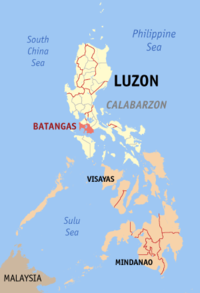Taal Lake
Taal Lake is a freshwater lake in the province of Batangas, on the island of Luzon, Philippines. The lake is situated within a caldera formed by very large eruptions between 500,000 and 100,000 years ago. It is the country's third largest lake (the largest being Laguna de Bay). The active Taal Volcano, which is the one responsible for the lake's sulfuric content, lies on an island in the center of the lake, called Volcano Island. The island is called pulo or islet by the locals. In addition, there is a crater lake on Volcano Island, which is in Lake Taal, which in turn is on Luzon (an island). That crater lake is the world's largest lake on an island in a lake on an island.
History
Taal Lake was once just an arm of Balayan Bay. However, after a series of major eruptions in the 16th century, the lake was closed off from the sea by newly-formed land bridges. Taal Lake's sole connection to the sea narrowed down into its sole draining river, the Pansipit River. Several centuries of precipitation have diluted the lake's once-saline waters into pure freshwater.
Succeeding eruptions buried numerous lakeside towns. Presently, only three towns are on the lake's shore. Old lakeside towns with buildings and walls are reported to be seen under the lake's waters.
Ecology
Because the lake was until recently, connected to the sea, it is home to many endemic species that have evolved and adapted to the desalination of the lake's waters.
Its most popular endemic species is the overharvested tawilis, the world's only freshwater sardine.
The lake has a freshwater-adapted population of trevally, Caranx ignobilis. These fish, also found in the Pansipit River, are locally called maliputo.
Taal Lake is also home to one of the world's rarest sea snakes, Hydrophis semperi. This particular species is only one of two "true" sea snake species that are known to live entirely in freshwater.
Bull sharks, Carcharhinus leucas, used to be part of the lake's once-diverse ecosystem. They were exterminated by the locals in the 1930s.
Fishkill
On January 5, 2008, the Bureau of Fisheries and Aquatic Resources (Philippines) (BFAR) announced that a fishkill at Taal Lake (January 2 to 4) caused the 50 metric tons or PhP 3.25-million (US$1=PhP41) loss of cultured tilapia in the villages of Leviste and Balakilong in Laurel and in Barangay Aya and Barangay Quiling in Talisay. 6,000 maliputo fishes (P 230,000) also died at Quiling. Toxic sulfur and high level of hydrogen sulfide in Ambulong while low dissolved oxygen caused the deaths
Tourism

Regular tours of the lake are available to tourists. After crossing the lake, visitors travel to the top of Volcano Island on horseback. During their trip up and down the mountain, visitors are treated to a stunning view of the lake and its surroundings.
In mid-2007, controversy ensued when the Korean firm Jung Ang Interventure was given clearance to build a health spa on Volcano Island itself along the lake's edge. Over the course of the next few weeks, several government officials expressed their disapproval of the construction project.
On June 28, the DENR suspended the Korean firm's environmental clearance certificate, rendering them incapable of pursuing further construction on the island until they secure other necessary permits. Because of the unpopular public reaction to the project, the Korean company's permit was permanently revoked by the DENR in early July 2007.
Gallery


